August Blue Moon 2024: What is it and when to watch this Blue Moon in the UK
16th Aug 2023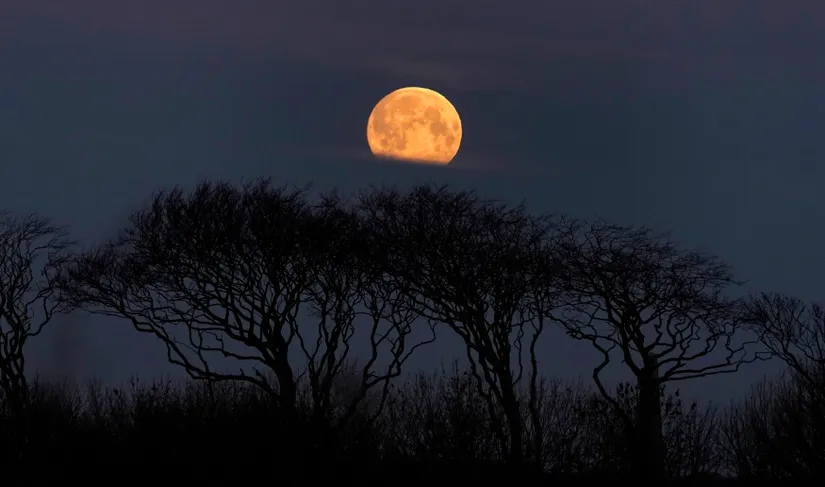
We all know the phrase “once in a Blue Moon”, meaning that something won’t happen soon or, possibly, will not happen at all. But did you know that the idiom did not arise from scratch, and the Blue Moon is not just a literary image but a real-life astronomical phenomenon?
In this article, you will find the answers: what is the Blue Moon, why is it called so, when is the next Blue Moon, and can we see it in the UK?
What does Blue Moon mean?
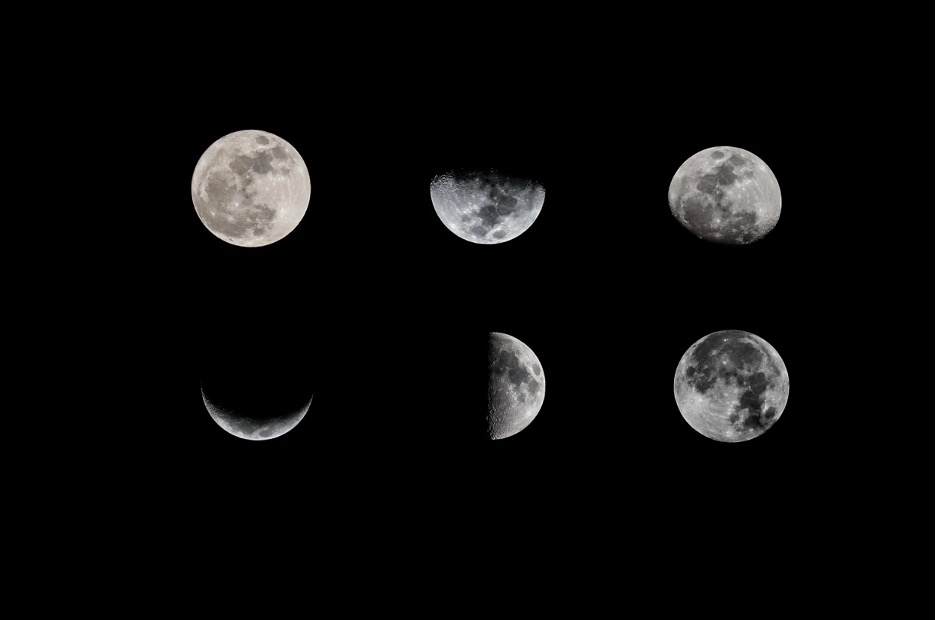
We are talking about the full moon — the lunar phase when the Earth’s satellite is in opposition to the Sun and is illuminated by it so that we can see its full disk. This usually happens once a month. If two full moons occur in one calendar month, then the second one is called the Blue Moon.
How often do we get a Blue Moon?
The phenomenon occurs approximately once every 2.7 years. Why is it so rare? Due to the unevenness in the lengths of the lunar cycle and the calendar. Based on the second condition, traditional seasonal and modern monthly Blue Moons are distinguished. Let’s see how these two are different.
What is a seasonal Blue Moon?
The seasonal or traditional Blue Moon is the third full moon in that astronomical season, which has four full moons instead of three. The early start of the seasons was determined not by the Gregorian calendar year but by the solar year. The solar year begins when the Earth returns to the same point relative to the Sun that it occupied at the beginning of the year. This point in the sky is called the spring equinox or the spring solstice. Thus, the countdown of the solar year does not begin on January 1 but on March 21 — on the day of the vernal equinox. On this day, spring begins. Then on June 22, on the day of the summer solstice, summer begins and lasts until September 21 — the day of the autumn equinox. Autumn begins on September 21st. And winter starts on December 22 with the winter solstice.
Since our natural satellite reaches a full moon approximately every 29.5 days, there are three full moons for each season, and the duration of 12 lunar cycles is 354 days. But the calendar year lasts 365 days, so this difference of days accumulates, and, according to the Gregorian calendar, there are not 12 but 13 full moons approximately once every 2.7 years. That is, in one of the seasons, there will be four full moons instead of three, and one of them will be ‘blue’.
Why is the seasonal Blue Moon the third full moon and not the fourth?
This decision was made due to religious holidays, many of which fell on the days of the spring/autumn equinox, as well as the summer/winter solstice.
Previously, the lunar calendar and the solar year played an important role in the lives of North American farmers. The boundaries of the seasons determined the beginning and end of fieldwork, and hunting seasons, and were associated with many rituals and religious holidays. Each full moon in the season, as a rule, had its own name: sacred or domestic. The first and last full moons of the season were of great religious significance. So that not to violate the order of naming these full moons and the holidays determined by them, it was decided to call the penultimate, that is, the third full moon, “blue”. The time of the next event and traditions, associated with it, were systematically described in a special magazine published for farmers called The Maine Farmers’ Almanac.
To this day, many religious holidays are still associated with the boundaries of the solar year seasons. For example, Christian Easter is celebrated on the first Sunday after the spring full moon after March 21st. That is why the concept of a seasonal Blue Moon is still defined by the third full moon.
What is a monthly Blue Moon?
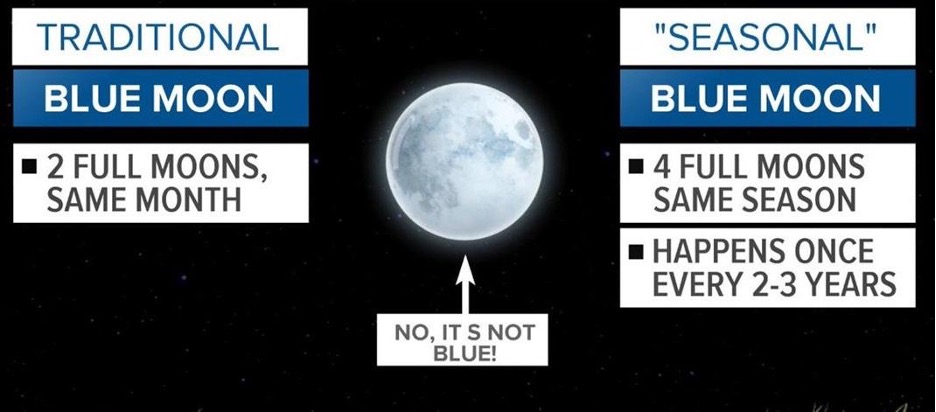
This is the phenomenon when two full moons occur within the same calendar month. Usually, one full moon happens once in a calendar month, but due to the difference in the duration of the average lunar cycle (29.5 days) and calendar months (30, 31, 28, 29 days), on rare occasions, two full moons can fit into one calendar month. The first one falls at the beginning and the second one — at the end of the month. This can happen in any month except February, which is initially less than the lunar cycle.
Why is there a monthly Blue Moon?
In 1946, American Sky & Telescope magazine gave a simplified explanation of this phenomenon: “Seven times in a 19-year cycle, there are years with 13 full moons. This gives us 11 months with one full moon and one month with two. This second one, as far as I understand, will be the Blue Moon”.
This interpretation seemed simpler and more understandable to the public, so the press picked it up and quickly became widespread. Since then, the monthly Blue Moon has been a valid definition for an extra full moon, along with the traditional seasonal one. In 2006, Texas astronomer Donald W. Olson, in a column for the same Sky & Telescope, described the situation as follows: “After two decades of popular use, the interpretation of the second full moon in a month is like a genie that cannot be put back into the bottle. But that’s not necessarily a bad thing.”
So why is the “extra” full moon called a blue one?
There are several versions to explain the ‘blue’ nickname. One of them was put forward by folklorist Philip Hiscock, who, studying Blue Moon facts, concluded that the idiom once in a Blue Moon appeared around the 18th-19th century and was already used at the time to mean something absurd that would never happen. “Extra” full moon happens every 2.7 years, which is probably why this phenomenon was called a Blue Moon.
According to another version, the modern word ‘blue’ comes from a distorted obsolete ‘belewe,’ which meant “to betray, let down”. An additional full moon in the spring months obligated people to fast for one more month before Easter, so they called it the “treacherous moon”, not actually a blue one.
And finally, people could see our satellite not as yellow or purple as it usually looks in the sky, but blue. You will be surprised, but a blue appearance is possible.
When can the moon look blue?
It happens very rarely that people can observe an optical effect which makes our planet’s satellite a bit blue. The fact is that light with short wavelengths, corresponding to the blue colour and its shades, is better scattered in the Earth’s atmosphere than light with long wavelengths. This happens because the frequency of the scattered light is much less than the natural frequency of the molecules; a similar phenomenon in physics is called Rayleigh scattering. In this case, the light is scattered by air molecules and dust particles from fires or volcanic eruptions.
For this reason, only in the last century and a half, at least two cases are known when people could have observed our celestial neighbour having a blue colour:
- In 1883, the Indonesian volcano Krakatau, during an eruption, threw ash up to 80 kilometres into the atmosphere. The smallest particles scattered the red light, and our planet’s satellite appeared blue-green through this ashy filter.
- In 1950, after a powerful peat bog fire in one of the Canadian provinces, thick smoke containing tiny particles of ash rose into the sky. Because of this, the Earth’s satellite, when viewed from the South and East of the country, appeared blue and even purple.
Despite situations where we can see our satellite in blue hues, this is just an optical effect and has nothing to do with full moons.
What year had 2 Blue Moons?
If the Blue Moon occurs approximately once every 2.7 years, then two Blue Moons in one year occur 3–5 times per century. The last time we could observe such a phenomenon was not so long ago, in 2018, in January and March. Those who missed it will have to wait… 14 years. The next time we will have two Blue Moons in one year will be in 2037.
How does a Blue Moon affect you?
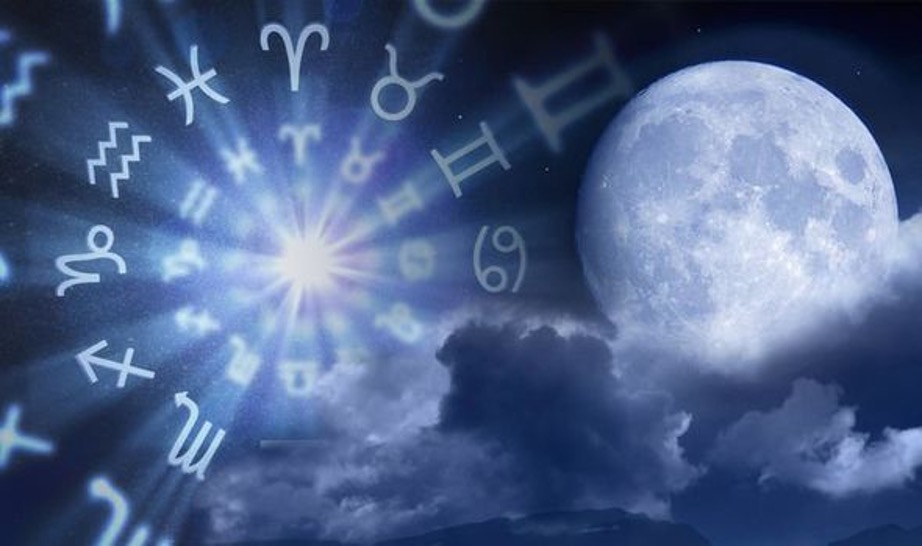
Observing the ebb and flow, caused by the gravitational forces of our satellite and the Sun, led people to the idea that different phases of the Moon affect our well-being in different ways. It is widely believed that during the full moon, we can experience sleep disturbances, feel sleepy, and anxious, experience headaches, have mood swings, heart rhythm disturbances, and even suffer panic attacks. Astrology also describes this phenomenon as a period of increased energy or an opportunity for personal growth and transformation.
But does the Blue Moon really affect your mood, health and life? In the scientific community, such myths and theories have no confirmation, so you should not associate any personal ups and downs with lunar cycles.
When’s the next Blue Moon?
We were very lucky to observe two full moons in August 2023. The first one was on August 1, and the Blue Moon could have been seen on August 30/31, 2023. It was something special because we were able to observe not just the second full moon in a month but also a supermoon.
What is a Super Blue Moon, you might ask. During this time, our satellite approaches the Earth at a minimum distance, which is why it appears much larger and brighter than on other full moons.
What made this supermoon even more exciting was its close encounter with Saturn. On the very same day, it embarked on a near approach to the planet Saturn, adding an extra layer of astronomical fascination to the night’s celestial show. In case you’ve missed it, here are your next opportunities.
Seasonal Blue Moon can be observed on
- 19th of August 2024;
- 20th of May 2027.
The next Monthly Blue Moon is expected to be on
- 31st of May 2026;
- 31st of December 2028.
Bookmark this page with our Blue Moon calendar to stay up to date with these amazing events. But even if you don’t remember the dates, it’s quite easy to distinguish between monthly and seasonal Blue Moons in the sky. The first one falls on the last days of any month except February; the second one — on the 19th-24th of February, May, August or November (one month before the solstice or equinox).
| YEAR | FIRST FULL MOON | BLUE MOON |
| 2020 | Oct 2, 2020 | Oct 31, 2020 |
| 2023 | Aug 1, 2023 | Aug 31, 2023 |
| 2026 | May 1, 2026 | May 31, 2026 |
| 2028 | Dec 2, 2028 | Dec 31, 2028 |
| 2031 | Sep 1, 2031 | Sep 30, 2031 |
| 2034 | Jul 1, 2034 | Jul 31, 2034 |
| 2037 | Jan 2, 2037 | Jan 31, 2037 |
| 2037 | Mar 2, 2037 | Mar 31, 2037 |
| 2039 | Oct 2, 2039 | Oct 31, 2039 |
Other planets we observed during the last Blue Moon
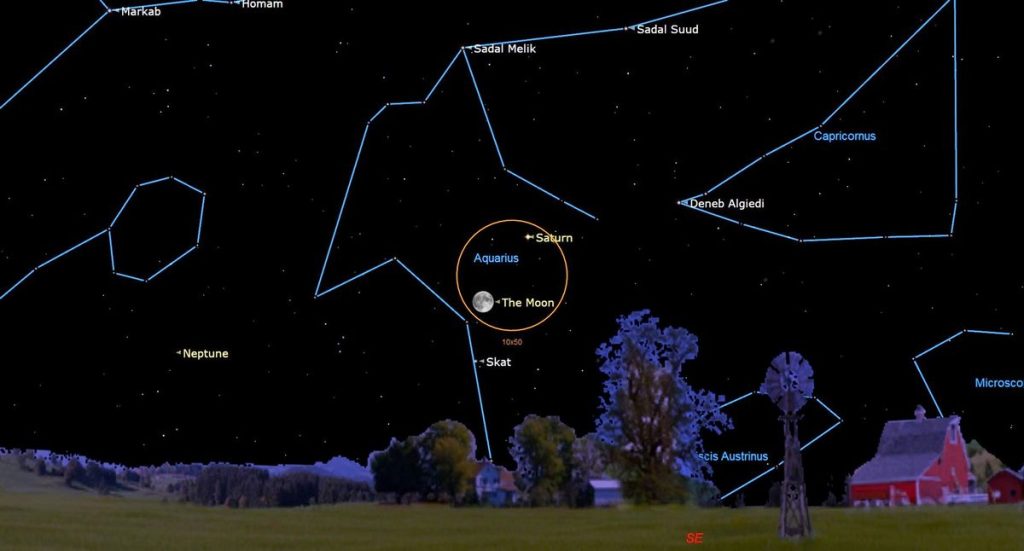
While Saturn kept a watchful eye on our satellite, drawing close even when it was not in conjunction, other planets also made their appearances.
Jupiter rose on August 31, offering a mesmerising display in the constellation Aries. Its brilliance set it apart from the surrounding stars, creating an unmistakable presence in the night sky. Mars, although less conspicuous, could still have been glimpsed during the evening hours. It required a stroke of luck and a clear, unobstructed horizon, as the planet was merely 6 degrees above the horizon half an hour after sunset.
Venus, on the other hand, took on the role of a “morning star.” It graced the morning sky on August 31 at 4:33 a.m. Its luminosity was so remarkable that it stood out boldly amidst the other stars, continuing to shine even as the rest of the stars began to fade.
Can you see the Blue Moon in the UK?
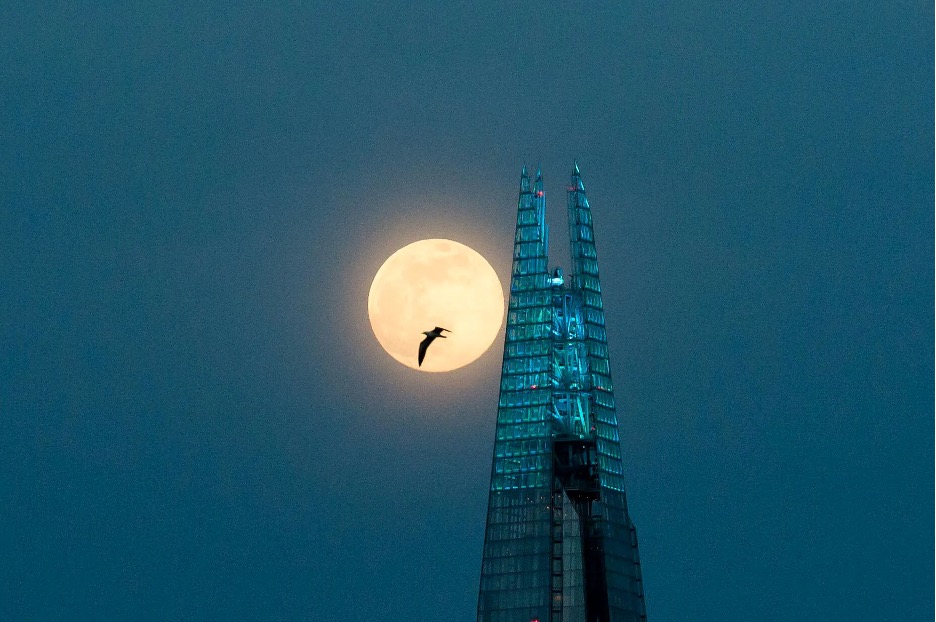
Residents of the UK can observe this super show, just like all other people on the planet. According to the US Naval Observatory, the next seasonal Blue Moon will rise in the sky on August 19, 2024, 18:26 GMT. It is better to admire this phenomenon through a telescope, but this spectacle will also be visible to the naked eye. We have put together a few tips on how you can better enjoy this phenomenon.
Tips for Enjoying the August 2024 Blue Moon
- Find a dark spot: to fully appreciate this seasonal Blue Moon’s splendour, head to an area away from city lights, which can diminish the moon’s brilliance.
- Use binoculars or a telescope: while the natural satellite is visible to the naked eye, using binoculars or a telescope can enhance your viewing experience, allowing you to observe craters and details on the lunar surface.
- Arrive early: plan to arrive a bit early to find a comfortable spot and settle in. Watching the moonrise can be as enchanting as its peak brightness.
- Capture the moment: if you’re into astrophotography, the August Blue Moon presents a fantastic opportunity to capture stunning shots. Experiment with different camera settings to achieve the best results.
So, as you can see, the phrase “once in a Blue Moon” did not come out of nowhere. The rare phenomenon of a double full moon exists, although it has little to do with the blue colour. Find it hard to believe? Watch the Blue Moon on August 19, and see for yourself.






Thank you for your comment! It will be visible on the site after moderation.